9 Foot Fractures
Overview
 Anatomic Features
Anatomic Features
The foot is made up of a total of 26 bones of different shapes, which are supported by a network of approximately 32 muscles and tendons, 109 ligaments, and 45 articulations.
The foot is divided into three sections: the forefoot, midfoot, and hindfoot. The forefoot is composed of five metatarsal bones and 14 phalanges, which make up the toes. The midfoot consists of five out of a total number of seven tarsal bones, including three cuneiforms, one tarsal navicular, and one cuboid bone. The hindfoot includes the calcaneus and talus bone. There are five metatarsal bones (labeled 1–5 starting at the big toe), each consisting of a shaft or body, and a base and head. The base is wedge shaped, expanding posteriorly. The head presents a convex articular surface, articulating distally with the phalangeal bones. There are 14 phalangeal bones of the foot, three in each toe except the big toe which has two, and each bone consists of a base, a body, and a head (Plate 9.1).
 OTA Classification and Coding System for Foot Fractures
OTA Classification and Coding System for Foot Fractures
According to the Orthopaedic Trauma Association (OTA) classification, a foot fracture is coded as the number “8” for its anatomic location; the talus, calcaneus, tarsal navicular, cuboid, cuneiforms, metatarsals, and phalanges are coded as the numbers “81,” “82,” “83,” “84,” “85,” “87,” and “88,” respectively. In addition, multiple fractures of the foot are coded as the number “89.” The classification varies with individual bones of the foot, due to complex anatomic features of each bone (Plate 9.2).
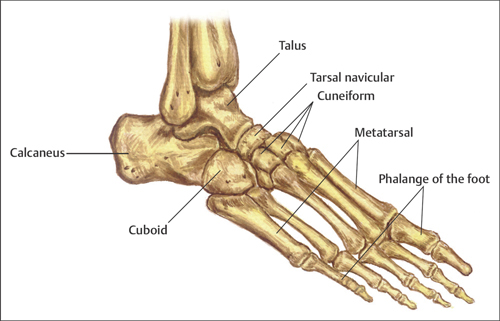
Plate 9.1
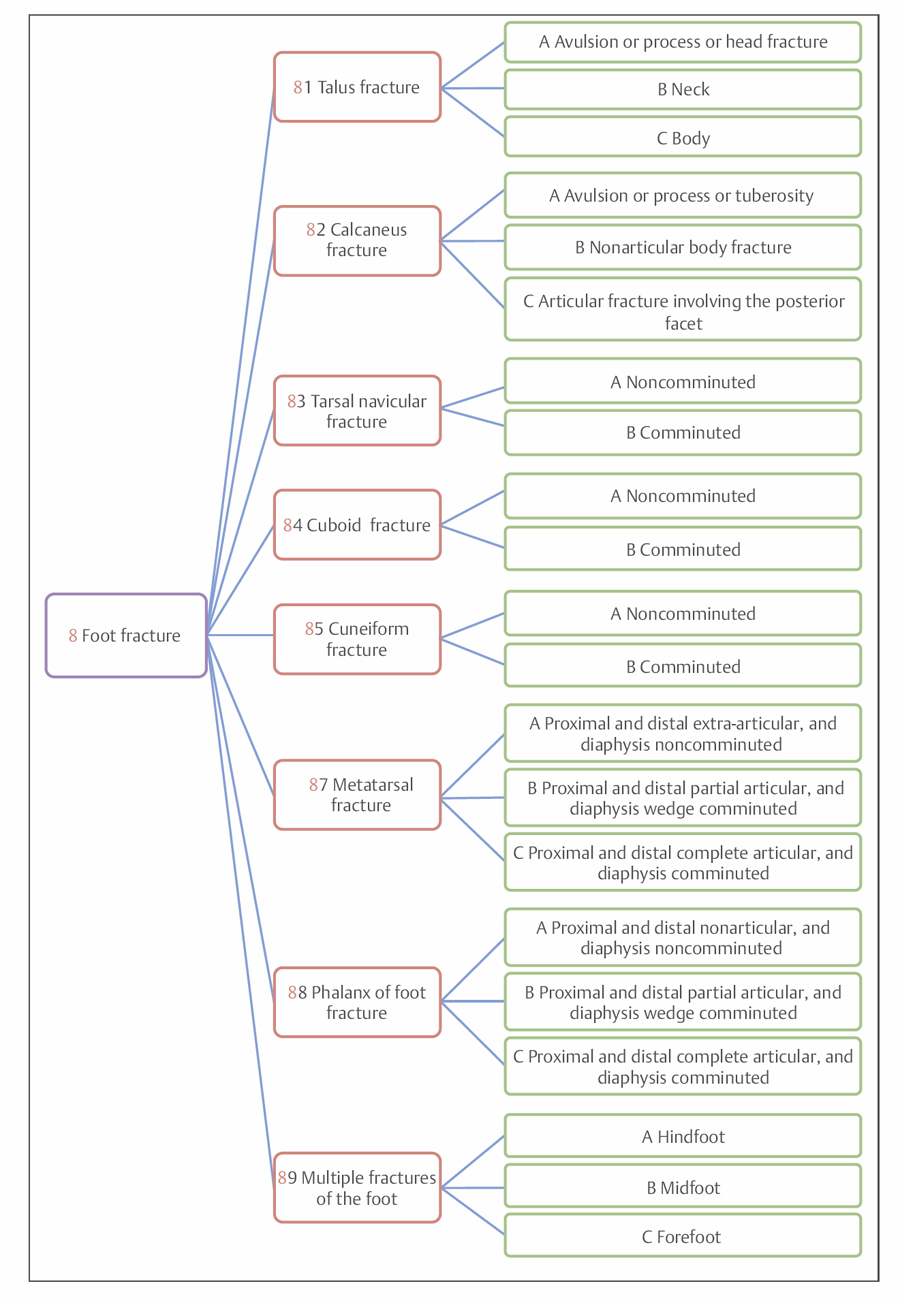
Plate 9.2
 Clinical Epidemiologic Features of Foot Fractures
Clinical Epidemiologic Features of Foot Fractures
A total of 6212 patients with 8015 foot fractures were treated at our trauma center over a 5-year period from 2003 to 2007. All cases were reviewed and statistically studied; the fractures accounted for 10.31% of all patients with fractures and 12.28% of all types of fractures. Among these 6212 patients, there were 422 pediatric patients (551 foot fractures) and 5790 adult patients (7464 foot fractures).
Epidemiologic features of foot fractures are as follows:
• more males than females
• slightly more left-side than right-side fractures
• the high-risk age group is 31–40 years—the same age group for males, whereas the high-risk age group for females is 41–50 years
• the most common foot fractures among adults are calcaneus fractures, in contrast to children, where the most common fractures are metatarsal.
 Fractures of the Foot by Sex
Fractures of the Foot by Sex
Table 9.1 Sex distribution of 6212 patients with foot fractures
| Sex | Number of patients | Percentage |
| Male | 4569 | 73.55 |
| Female | 1643 | 26.45 |
| Total | 6212 | 100.00 |

Fig. 9.1 Sex distribution of 6212 patients with foot fractures.
 Fractures of the Foot by Fracture Side
Fractures of the Foot by Fracture Side
Table 9.2 Fracture side distribution of 6212 patients with foot fractures
| Fracture side | Number of patients | Percentage |
| Left | 2992 | 48.16 |
| Right | 2939 | 47.31 |
| Bilateral | 281 | 4.52 |
| Total | 6212 | 100.00 |

Fig. 9.2 Fracture side distribution of 6212 patients with foot fractures.
 Fractures of the Foot by Age Group
Fractures of the Foot by Age Group
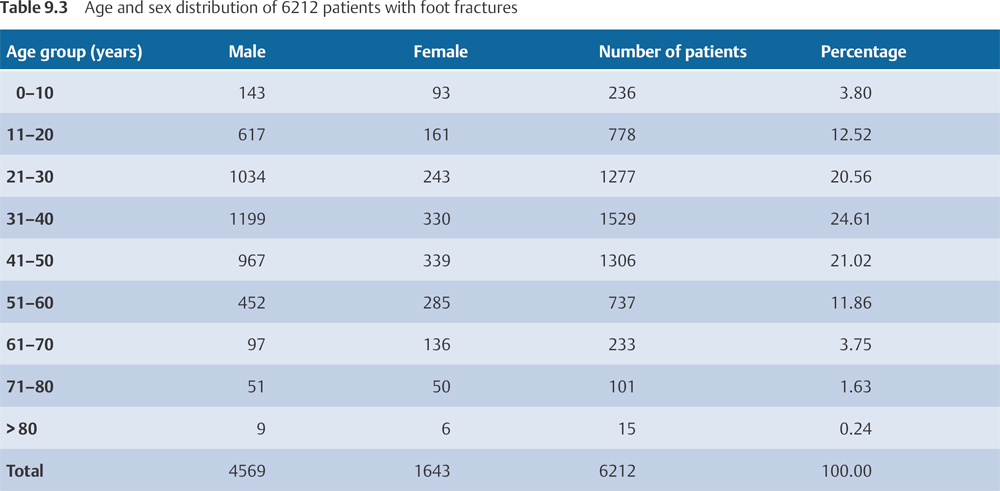
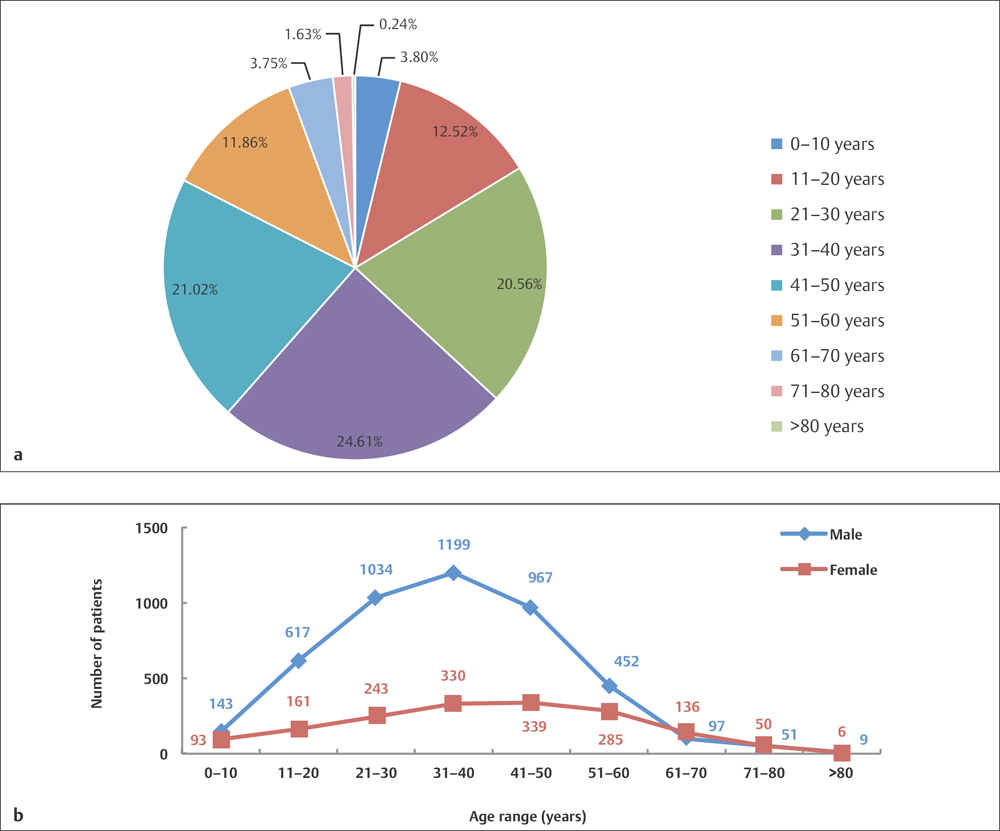
Fig. 9.3 a, b
a Age distribution of 6212 patients with foot fractures.
b Age and sex distribution of 6212 patients with foot fractures.
 Fractures of the Foot in Children and Adults by Individual Foot Bone
Fractures of the Foot in Children and Adults by Individual Foot Bone
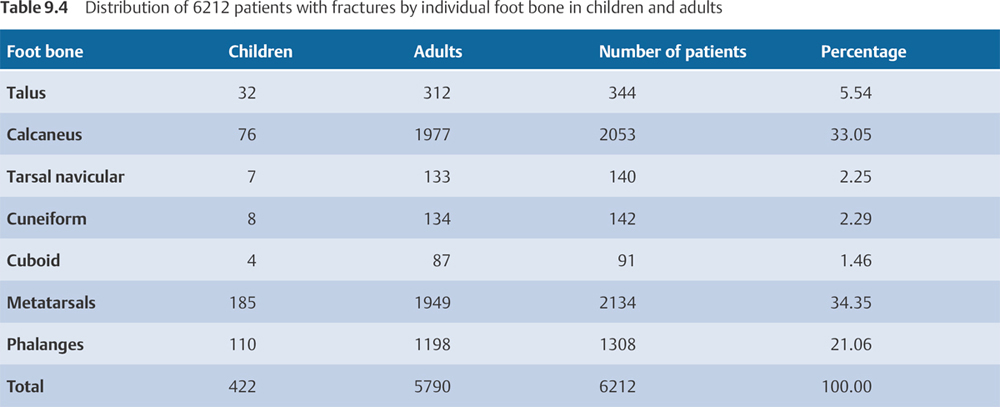
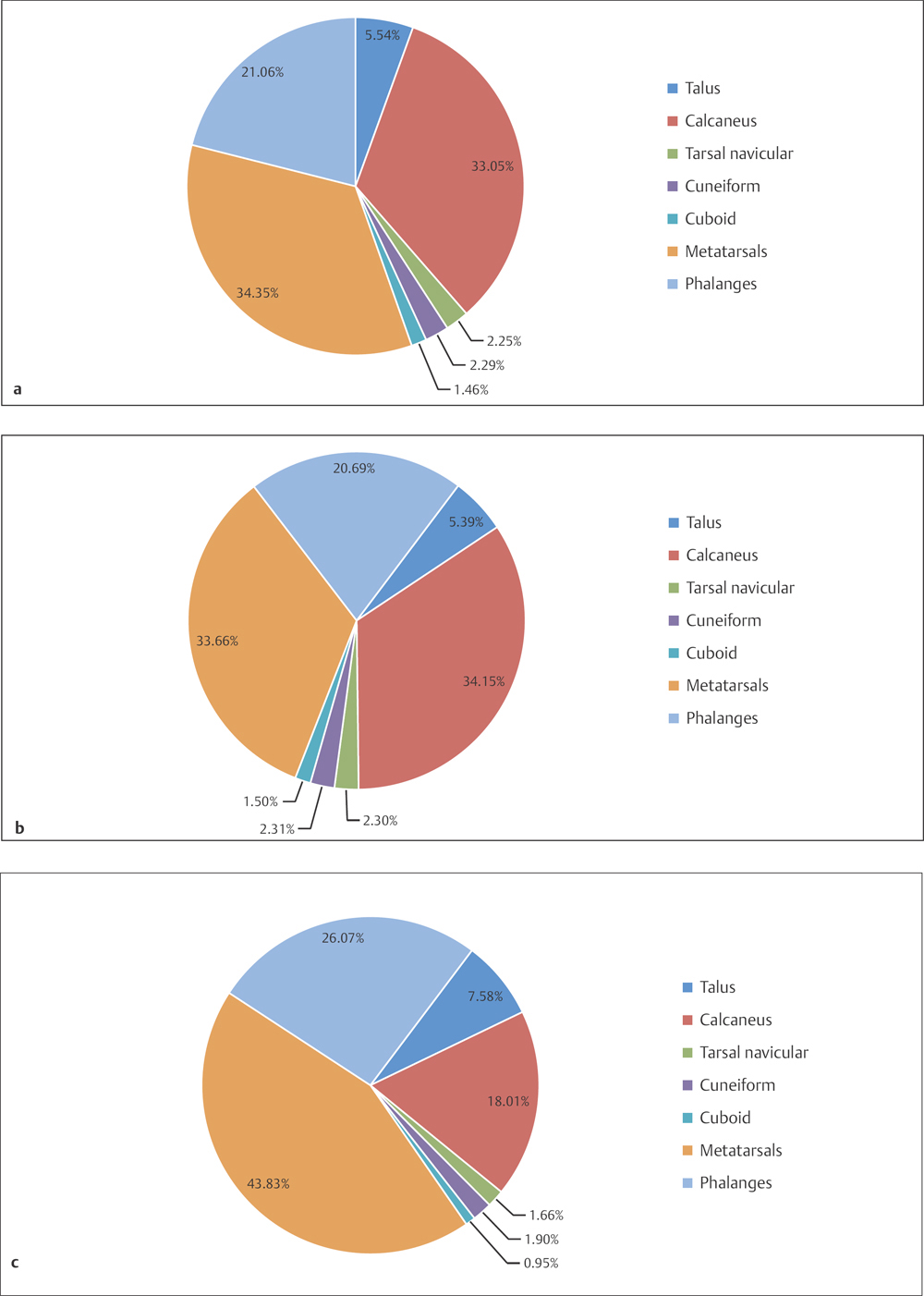
Fig. 9.4 a–c
a Distribution of 6212 patients with foot fractures by individual foot bone.
b Distribution of 5790 adult patients with foot fractures by individual foot bone.
c Distribution of 422 pediatric patients with foot fractures by individual foot bone.
Talus Fractures (Segment 81)
 Anatomic Features
Anatomic Features
Examining its anatomic region, the talus bone can be subdivided into three parts: the head, neck, and body. Between 60% and 70% of the talus surface is articular, forming seven articulations with adjacent bones.
The head is semicircular in form, carrying the articulate surface of the navicular bone. The neck, the constricted area between the body and head, is roughened for the attachment of the joint capsule. The irregular body is cuboid in shape, wide in the front and narrow in the back, which gives stability when the ankle is dorsiflexed. While its superior, medial, and lateral articulate surfaces join together to make up the trochlea of the talus, the posterior surface (facies articularis calcanea posterior) is separated by a furrow, the sulcus tali, which, together with the sulcus calcanei, forms a cavity, the sinus tarsi. Behind the trochlea is a posterior process with a medial and lateral tubercle separated by a groove for the flexor hallucis longus tendon. The medial and lateral tubercles give attachment to the medial talocalcaneal ligament and the posterior talofibular ligament, respectively. The medial articulate surface of the body, which is semilunar in shape, is only half the area of the lateral triangle surface of the body. The lateral surface projects laterally as a broad-based, wedge-shaped prominence, referred to as the lateral talar process, from which the lateral talocalcaneal ligament originates and passes immediately beneath its fibular facet to the lateral surface of the calcaneus.
The subtalar joint consists of three articulating surfaces: the anterior, middle, and posterior facets, with the posterior facet representing the major weight-bearing surface. The anterior and the middle facets usually conjoin as one anterior articulation facet (Plate 9.3).
 OTA Classification of Talus Fractures
OTA Classification of Talus Fractures
Base on the OTA classification, the talus is coded as the number “81” for its anatomic location. According to fracture location, talus fractures can be divided into three types: 81-A: avulsion, process, or head fractures; 81-B: neck fractures; and 81-C body fractures (Plate 9.4).
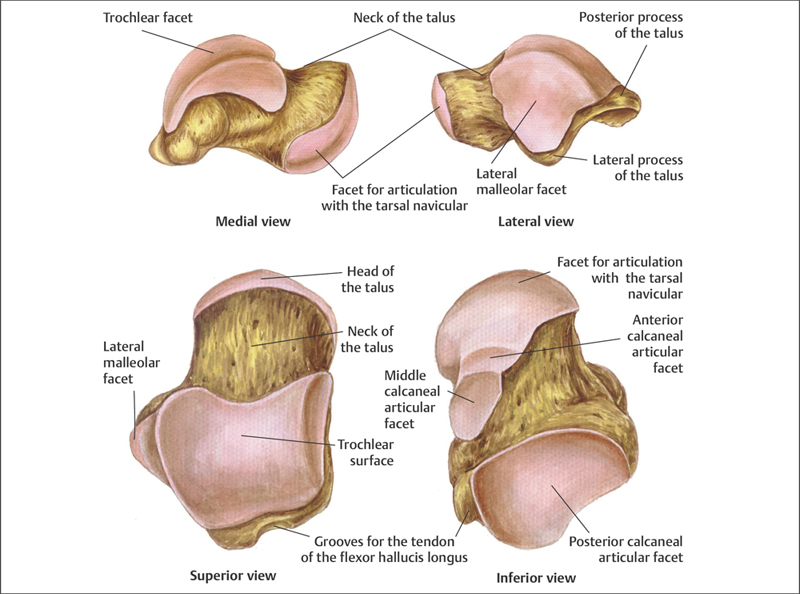
Plate 9.3
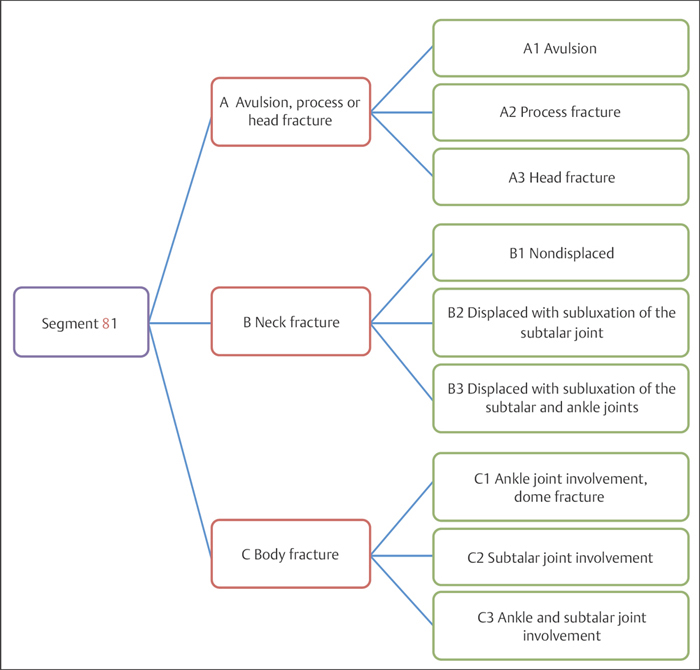
Plate 9.4
 Clinical Epidemiologic Features of Talus Fractures
Clinical Epidemiologic Features of Talus Fractures
A total of 312 adult patients with 316 talus fractures were treated at our trauma center over a 5-year period from 2003 to 2007. All cases were reviewed and statistically studied, including 157 patients with left-side fractures, 151 with right-side fractures, and four with bilateral fractures. There were 253 males and 59 females.
Epidemiologic features of talus fractures are as follows:
• more males than females
• the high-risk age group is 31–40 years, the same age group for both males and females
• the most common fracture type is type 81-B—the same type for both males and females
• the most common fracture group is group 81-A1—the same group for females, while the most common fracture group for males is group 81-C3.
 Talus Fractures (Segment 81) by Sex
Talus Fractures (Segment 81) by Sex
Table 9.5 Sex distribution of 312 patients with talus fractures
| Sex | Number of patients | Percentage |
| Male | 253 | 81.09 |
| Female | 59 | 18.91 |
| Total | 312 | 100.00 |

Fig. 9.5 Sex distribution of 312 patients with talus fractures.
 Talus Fractures (Segment 81) by Age Group
Talus Fractures (Segment 81) by Age Group

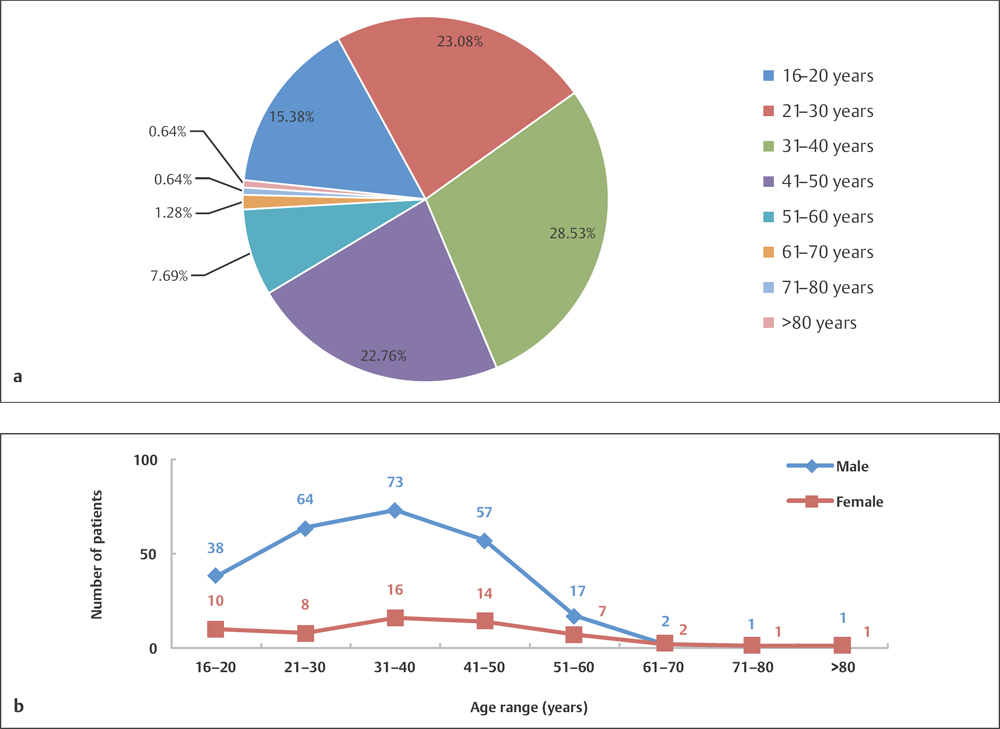
Fig. 9.6 a, b
a Age distribution of 312 patients with talus fractures.
b Age and sex distribution of 312 patients with talus fractures.
 Talus Fractures (Segment 81) by Fracture Type
Talus Fractures (Segment 81) by Fracture Type

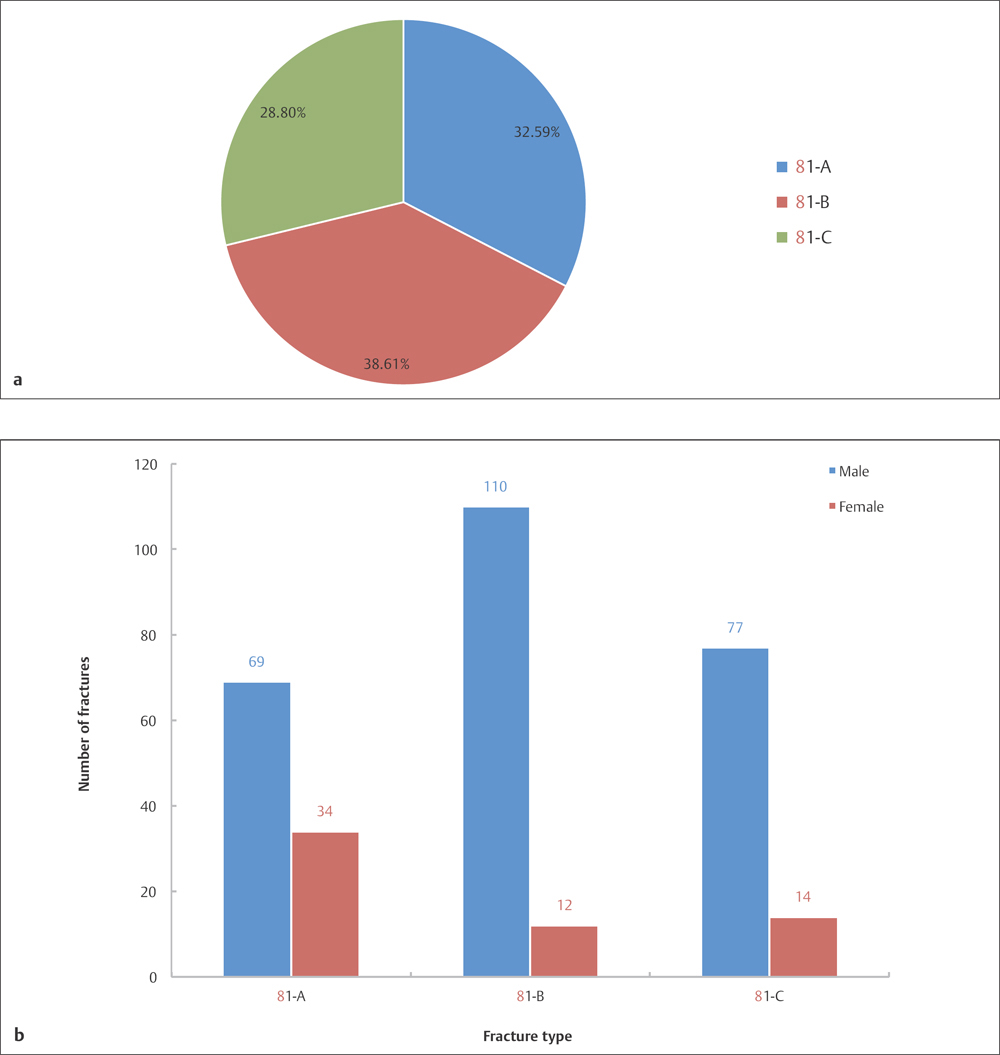
Fig. 9.7 a, b
a Fracture type distribution of 316 talus fractures.
b Sex and fracture type distribution of 316 talus fractures.
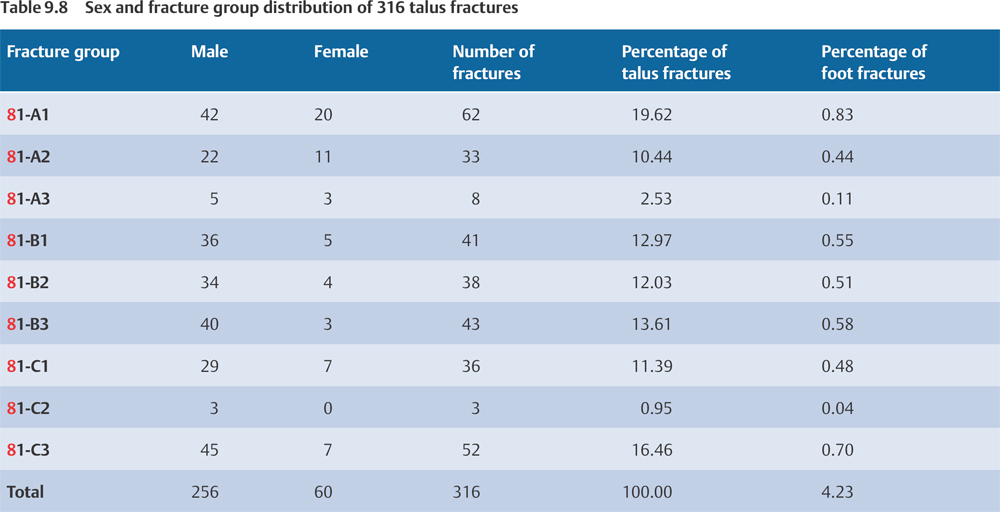

Fig. 9.8 a, b
a Fracture group distribution of 316 talus fractures.
b Sex and fracture group distribution of 316 talus fractures.
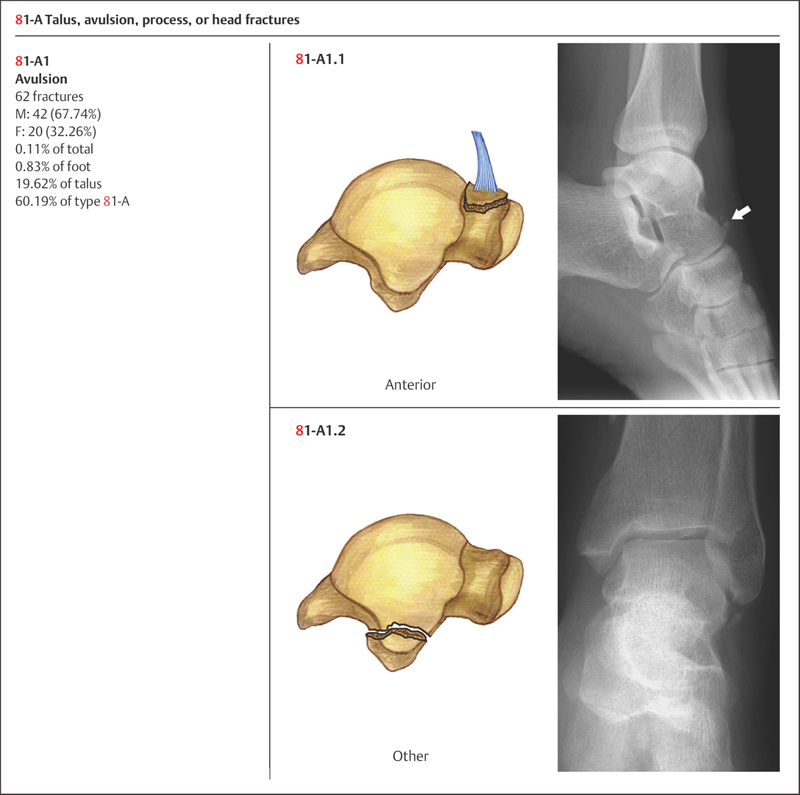

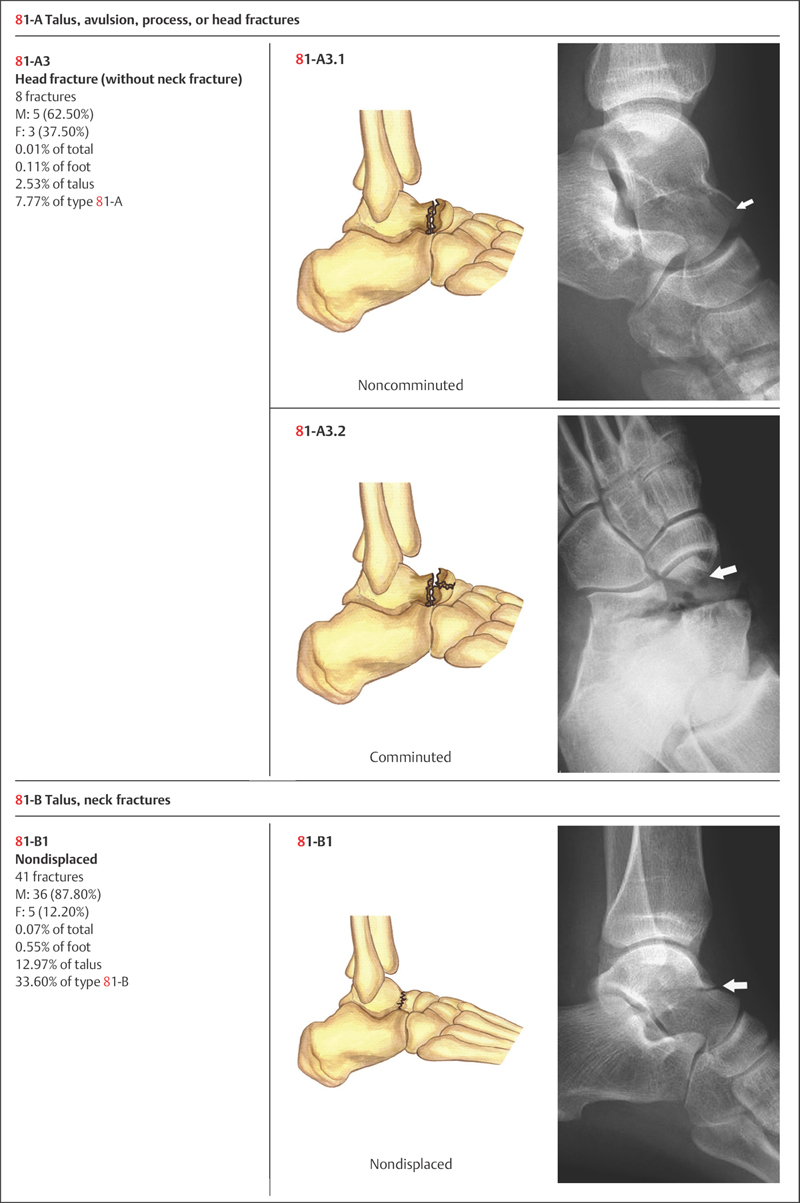
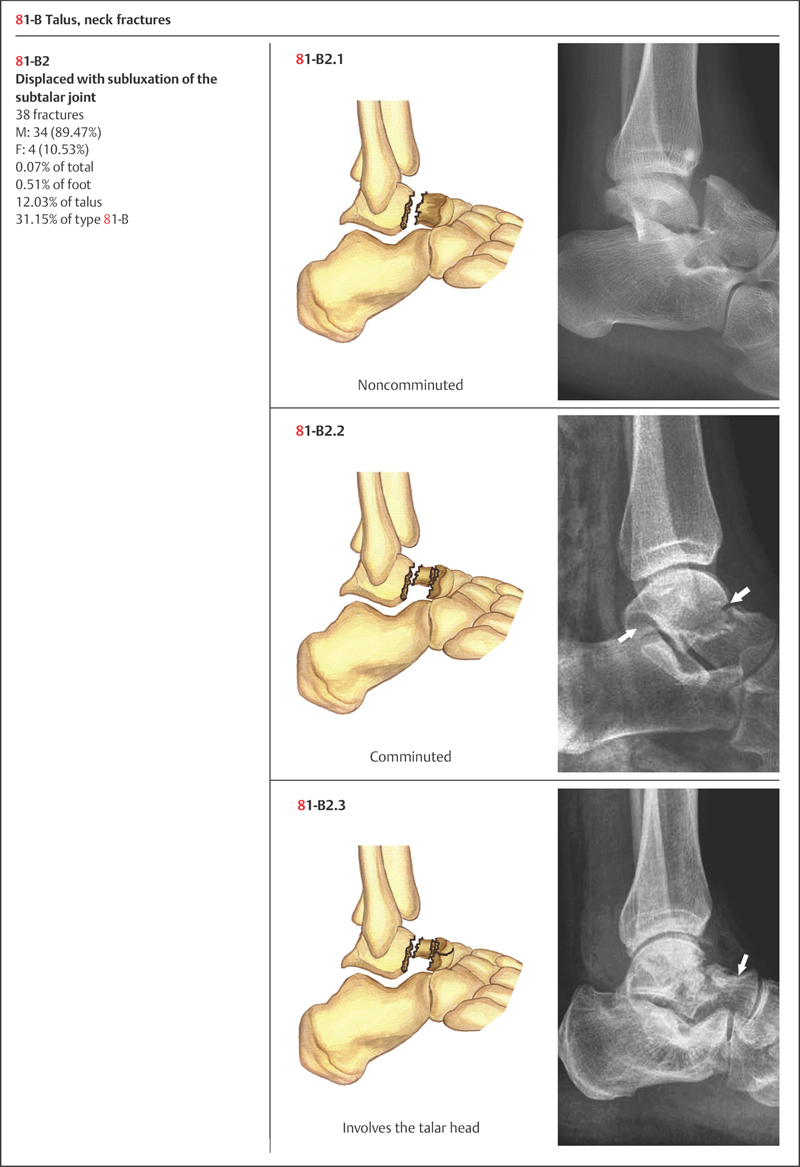
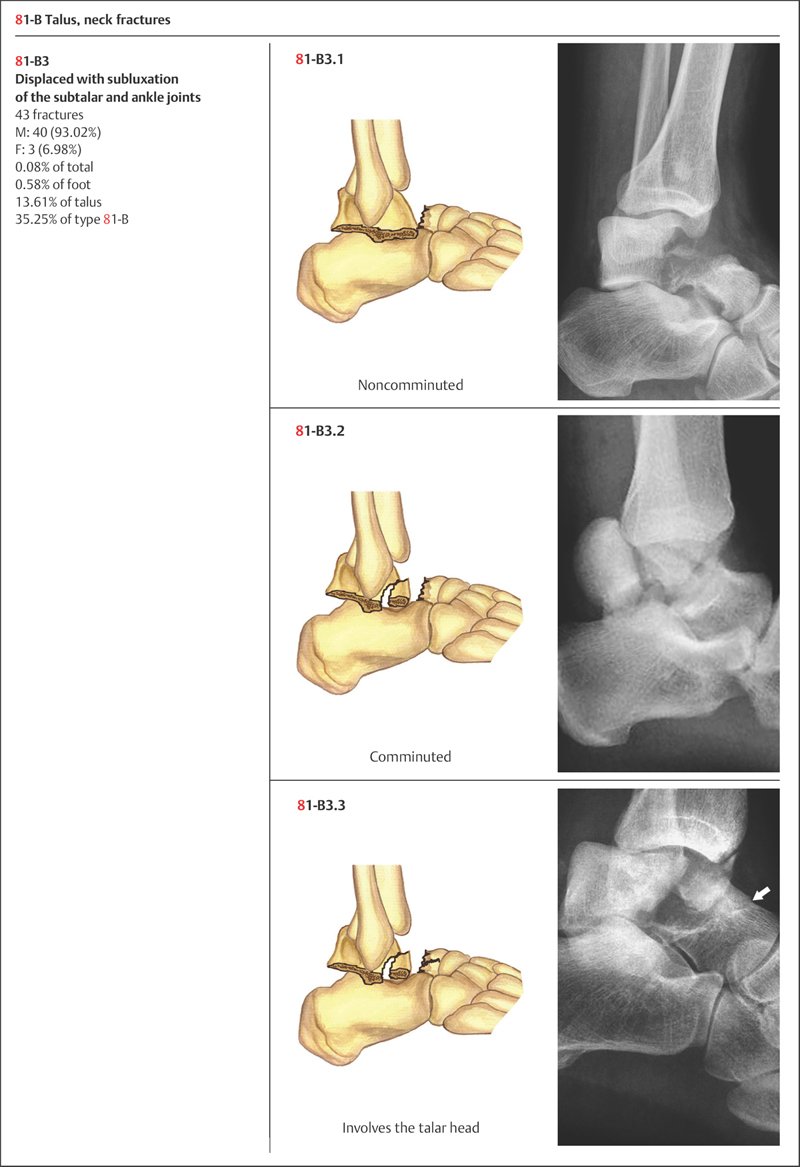
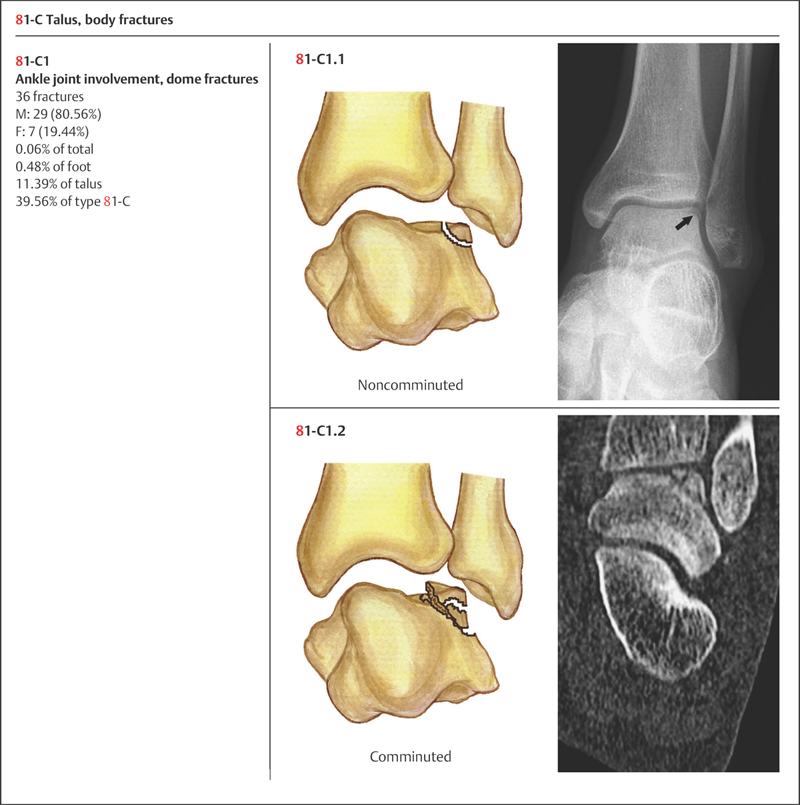
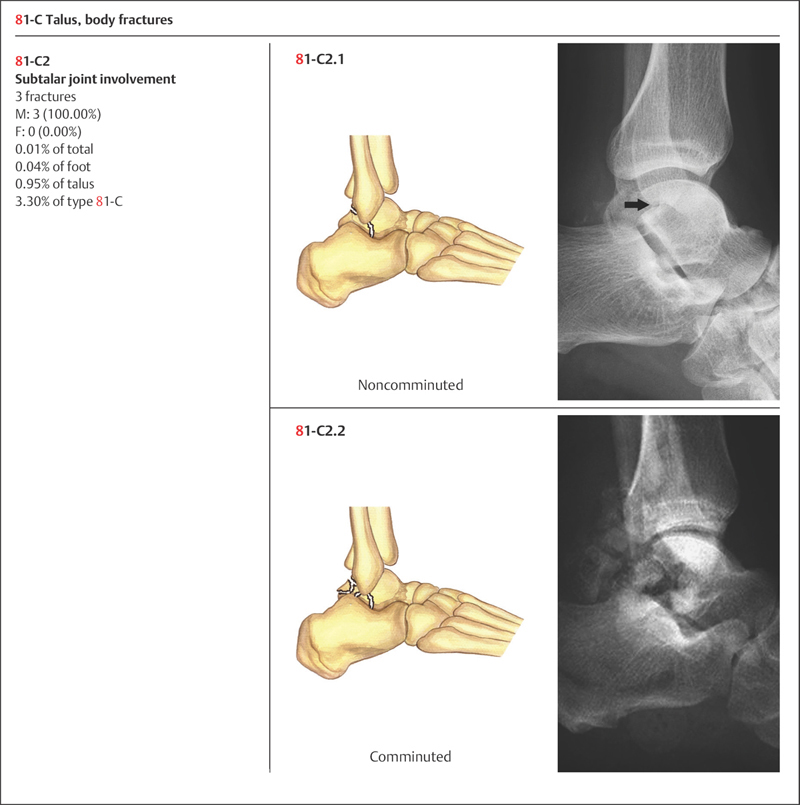
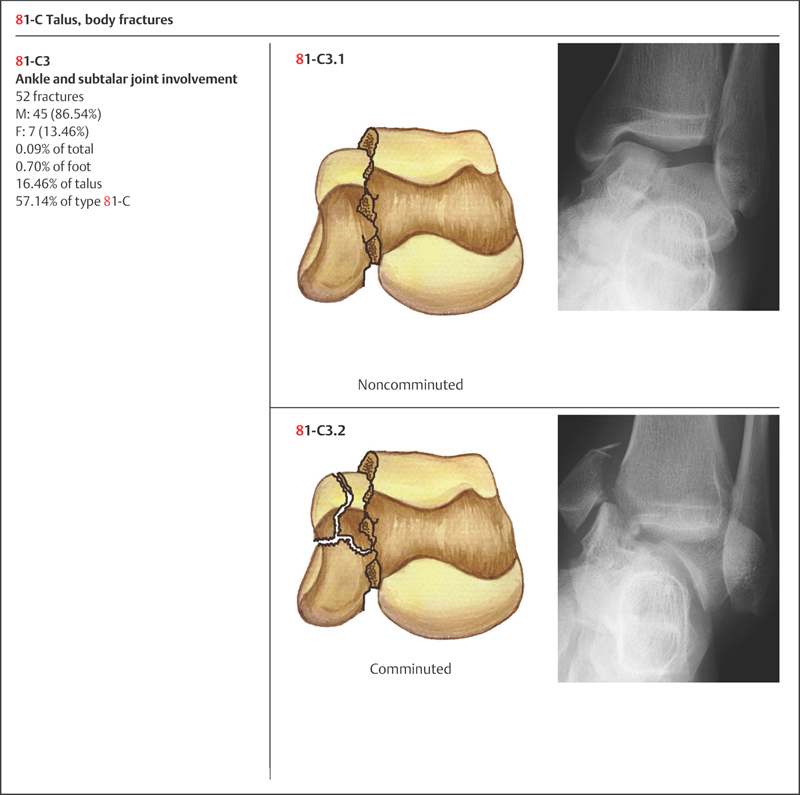
 Mechanism of Injury
Mechanism of Injury
Neck fractures are the most common talar fractures. The usual mechanism is associated with hyperdorsiflexion of the ankle as the talar neck impacts the anterior margin of the tibia, as may occur in an automobile accident or a fall from a height. The body of the talus locks in the ankle mortise following a talar neck fracture, and the remaining portion of the foot, including the head and calcaneus, is displaced medially. The continuous axial load may rupture the interosseous talocalcaneal ligament, the posterior talofibular ligament, and the posterior talocalcaneal ligament, causing the body of the talus to move out of the ankle mortise posteromedially. The resultant fracture line will run obliquely upward and laterally.
Body fractures of the talus occur most commonly as the result of axial compression load, as seen in a fall from a significant height. Ankle joint fractures may also accompany this injury. Fractures of the posterior and lateral processes are often results of violent contraction of nearby attached muscles as the injury occurs.
Talar head fractures are relatively uncommon, usually resulting from force transmitted along the metatarsal rays to the talar head.
 Diagnosis
Diagnosis
Most talar fractures are marked by acute pain, considerable swelling and tenderness, and limited or partially limited motion. If fractures are displaced markedly or the injury results in dislocation, deformity may present. The anteroposterior (AP) view of the ankle joint can reveal most talar fractures, while the oblique view provides better visualization of the head and neck of the talus, even with small fragments. It is important to note the extension and direction of fracture displacement and the presence of fractures of adjacent articulations. Particular attention should be given to the ankle mortise, the distal tibia, and the remaining tarsal, to rule out possible fractures. Computed tomography (CT) scan and magnetic resonance imaging (MRI) can better reveal the nature of the fractures and provide accurate assessment of the articular involvement, as well as the degree of fracture displacement.
 Treatment
Treatment
Stable nondisplaced talar body fractures and avulsion fractures can be treated with immobilization with casting. Nondisplaced, unstable fractures and displaced talar body fractures can be managed by fixation of compression screws with minimally invasive techniques. Comminuted fractures can be treated with secondary arthrodesis if there is persistent pain or swelling. Stable nondisplaced talar neck fractures can be treated nonsurgically, in contrast to displaced talar neck fractures, which require surgical intervention. A displaced talar neck fracture with associated dislocation may be treated first with closed reduction. Emergency open reduction and internal fixation may be indicated if closed reduction fails.
 Other Common Classifications of Talus Fractures
Other Common Classifications of Talus Fractures
 Types of Talus Fractures Classified According to Fracture Location
Types of Talus Fractures Classified According to Fracture Location
 Hawkins classification of Talar Neck Fractures
Hawkins classification of Talar Neck Fractures
• Type I: Nondisplaced
• Type II: Associated subtalar subluxation or dislocation
• Type III: Associated subtalar and ankle dislocation
• Type IV: (Canale and Kelley)
Type IV with associated talonavicular subluxation or dislocation (see Plate 9.5).
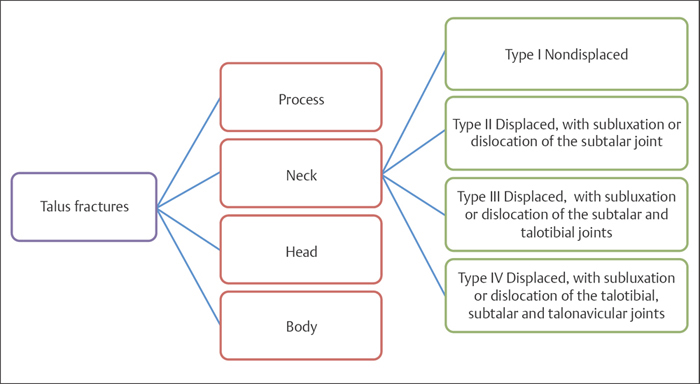
Plate 9.5
 Clinical Epidemiologic Features of Talus Fractures According to Fracture Location
Clinical Epidemiologic Features of Talus Fractures According to Fracture Location
A total of 316 adult talus fractures were treated at our medical center from 2003 to 2007. All cases were reviewed and statistically studied. Their epidemiologic features are as follows:
• talar neck fractures are the most common talus fracture
• type I fractures are the most common type of talar neck fracture
• talar head fractures are rare, only comprising 2.53% of talus fractures.
 Talus Fractures by Fracture Location
Talus Fractures by Fracture Location

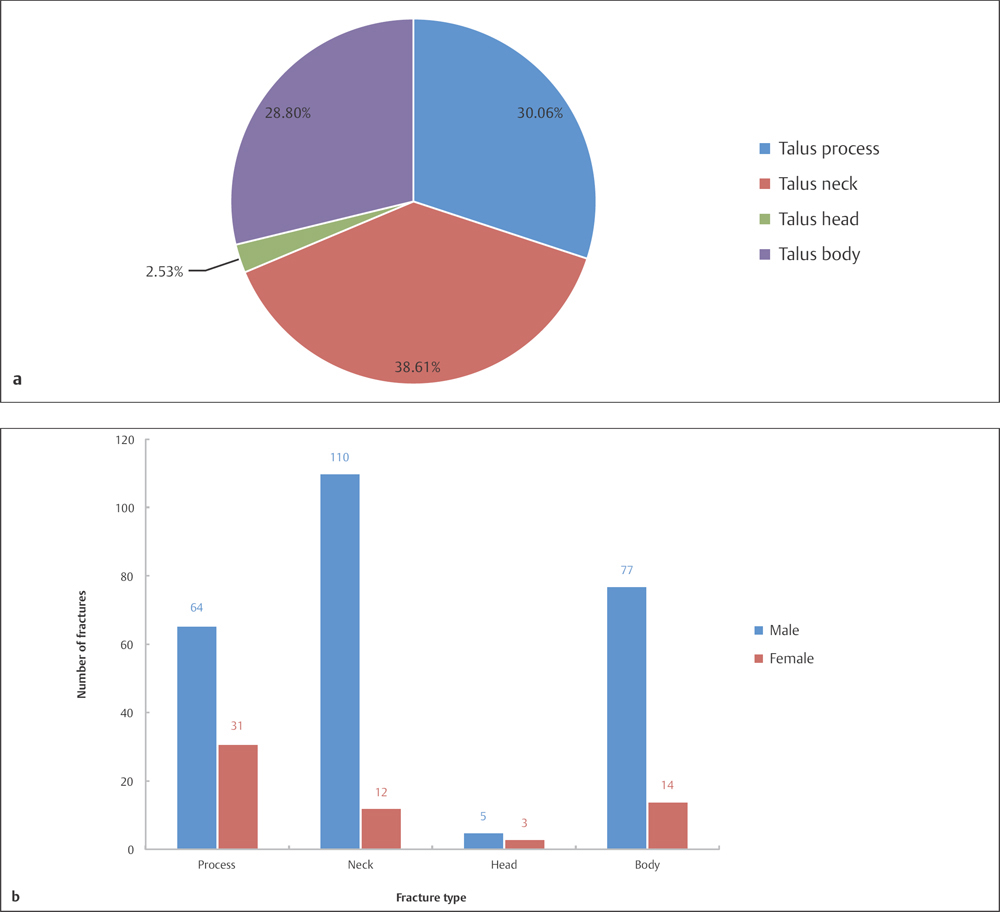
Fig. 9.9 a, b
a Fracture location distribution of 316 talus fractures.
b Sex and fracture location distribution of 316 talus fractures.

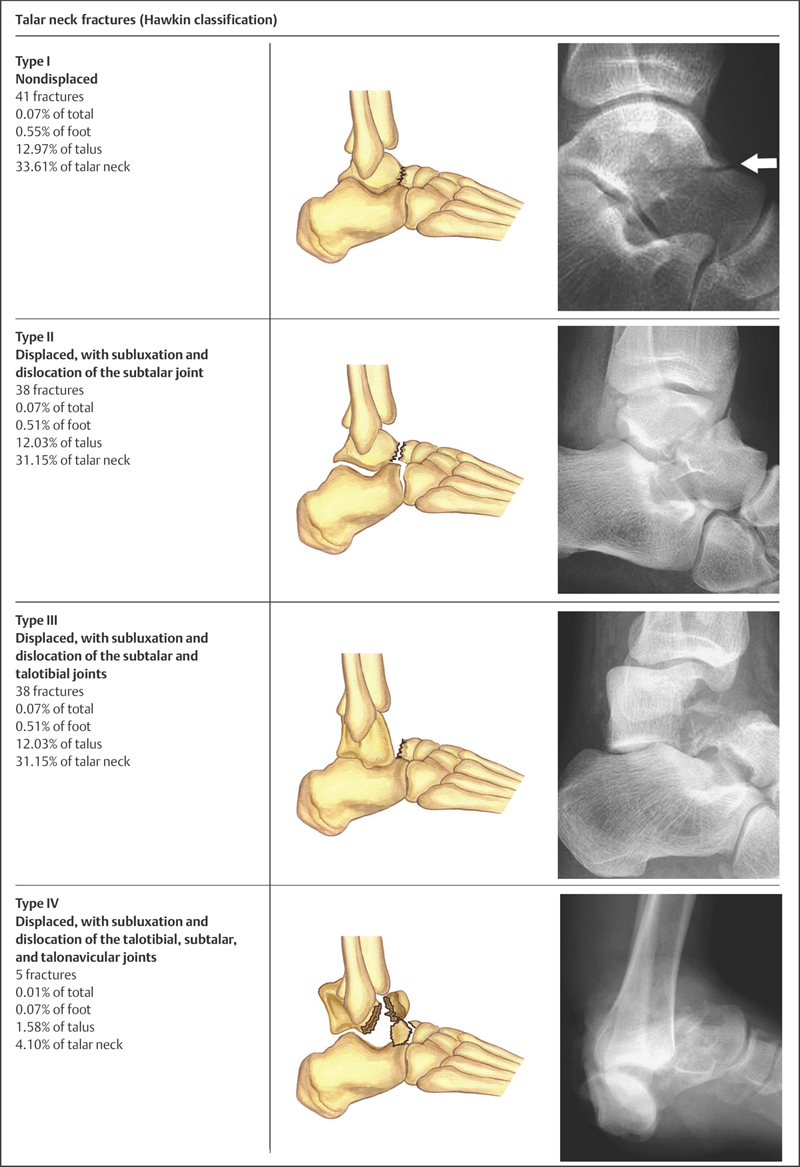
Calcaneus Fractures (Segment 82)
 Anatomic Features
Anatomic Features
The calcaneus is the largest of the tarsal bones; rectangular in shape, it lies inferior to the talus. The calcaneus has six surfaces: superior, inferior, anterior, posterior, medial, and lateral; it has three talocalcaneal facets on its upper surface, and one calcaneocuboid facet on its front.
Superior: On its upper surface are three smooth facets, posterior, middle, and anterior, which articulate with the lower surface of the talus to form the subtalar joint. The middle one-third of the surface is the posterior facet, which is large and oval or oblong. It is anteriorly tilted, at an angle of 45° from the midsagittal plane. The middle and anterior facets are located on the medial side of the upper calcaneal surface and are usually continuous with each other. On the medial side of the bone, below the middle talocalcaneal facet, is a shelflike projection, the sustentaculum tali, which supports the talar neck and also serves for the attachment of several ligaments. The posterior one-third surface of the upper calcaneal surface is roughened and is in between the posterior aspect of the ankle joint and the Achilles tendon.
Inferior: The inferior roughened area of the calcaneus gives attachment for the long plantar ligament and the quadratus plantae. The plantar-surface forepart of the calcaneus is a small rounded projection known as the small calcaneal tubercle, which gives attachment to the plantar calcaneocuboid ligament. The back part of the plantar surface is an eminence called the calcaneal tubercle.
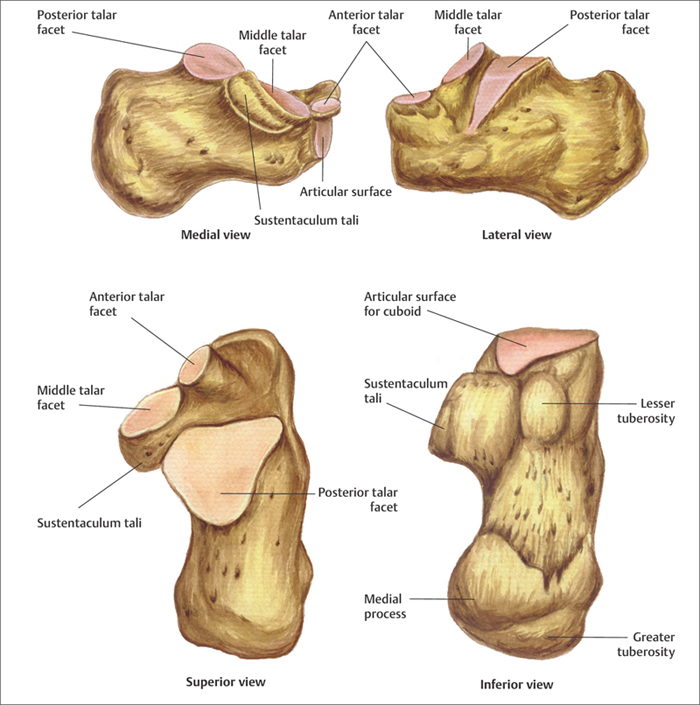
Plate 9.6
Medial: The medial wall of the calcaneus is depressed. Under the surface of the sustentaculum tali of the calcaneus, there is a groove running obliquely downward from posterior to anterior, which contains the flexor hallucis longus tendon.
Lateral: The lateral wall of the calcaneus is flat and smooth, except for a small ridge called the peroneal tubercle. Passing below the peroneal tubercle of the calcaneus is the groove for peroneus longus tendon.
Anterior: The anterior surface of the calcaneus, which is square in shape, has the smallest surface of all and has a saddle-shaped articulation, forming the calcaneocuboid joint with the cuboid bone.
Posterior: The posterior half of the calcaneus is an oval-shaped projection, which can be subdivided into three parts: upper, middle, and lower. The upper part of the posterior surface of the calcaneus is separated from the Achilles tendon by the subtendinous bursa and fat tissue; the middle part of the posterior surface, broad and rough, is the insertion point of the Achilles tendon; while the lower part is at a forward decline and continues with the calcaneal tuberosity. On the lower edge of the calcaneal tuberosity, on either side, are its lateral and medial processes, serving as the origins of the abductor hallucis and abductor digiti minimi (Plate 9.6).
 OTA Classification of Calcaneal Fractures
OTA Classification of Calcaneal Fractures
Based on OTA classification, the calcaneus is coded as the number “82” for its anatomic location. According to fracture location, calcaneal fractures are classified into three types: 82-A: avulsion, process, or tuberosity; 82-B extra-articular body fractures; and 82-C: articular fractures involving the posterior facet (Plate 9.7).
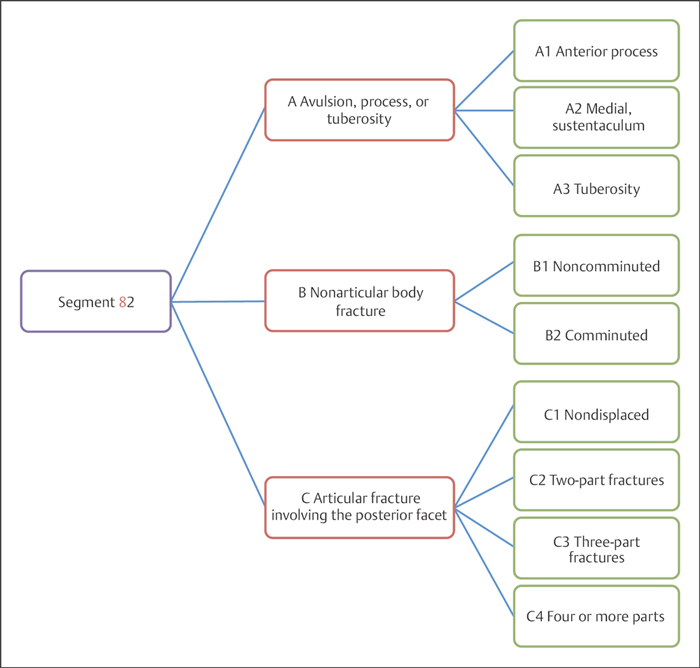
Plate 9.7
 Clinical Epidemiologic Features of Calcaneal Fractures (Segment 82)
Clinical Epidemiologic Features of Calcaneal Fractures (Segment 82)
A total of 1977 adult patients with 2222 calcaneal fractures were treated at our trauma center over a 5-year period from 2003 to 2007. All cases were reviewed and statistically studied, including 874 patients with fractures on the left side, 858 on the right side, and 245 bilateral. There were 1693 males and 284 females.
Epidemiologic features of calcaneal fractures are as follows:
• more males than females
• the highest-risk age group is 31–40 years—the same age group for both males and females
• the most common fracture type is type 82-C.
 Calcaneal Fractures by Sex
Calcaneal Fractures by Sex
Table 9.10 Sex distribution of 1977 patients with calcaneus fractures
| Sex | Number of patients | Percentage |
| Male | 1693 | 85.63 |
| Female | 284 | 14.37 |
| Total | 1977 | 100.00 |

Fig. 9.10 Sex distribution of 1977 patients with calcaneal fractures.
 Calcaneal Fractures by Age Group
Calcaneal Fractures by Age Group
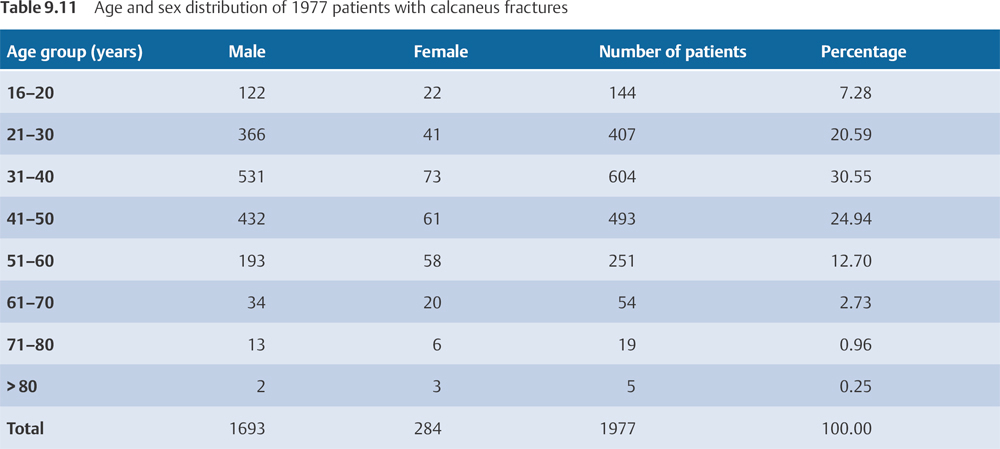
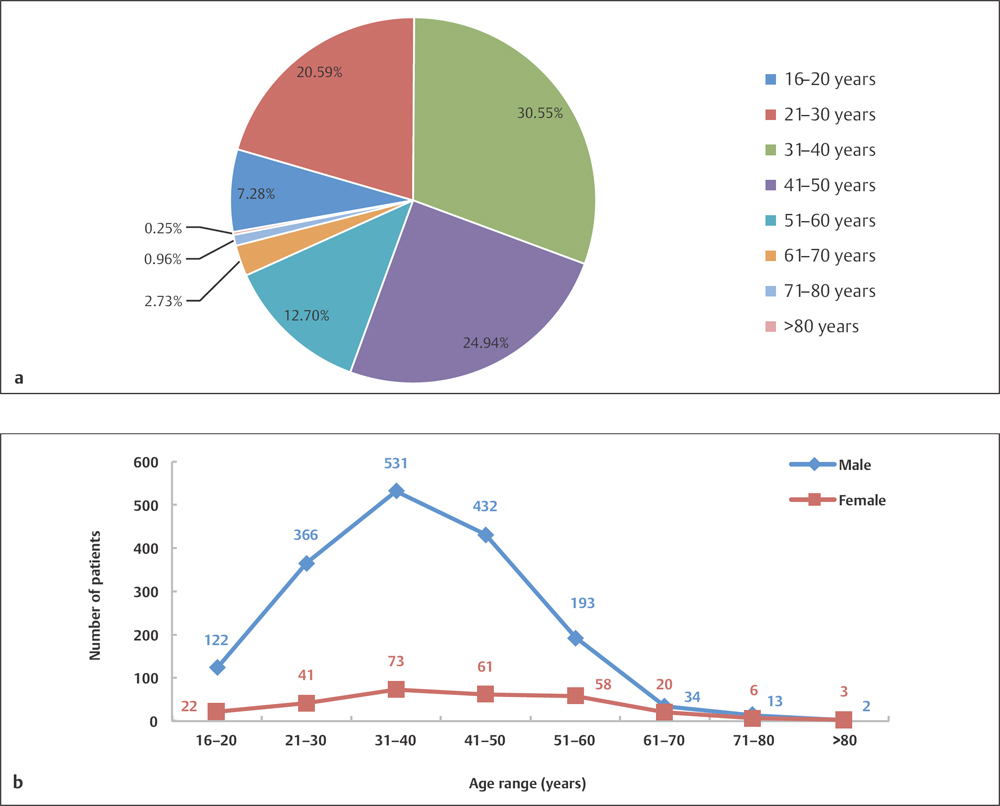
Fig. 9.11 a, b
a Age distribution of 1977 patients with calcaneal fractures.
b Age and sex distribution of 1977 patients with calcaneal fractures.
 Calcaneal fractures by Fracture Type
Calcaneal fractures by Fracture Type

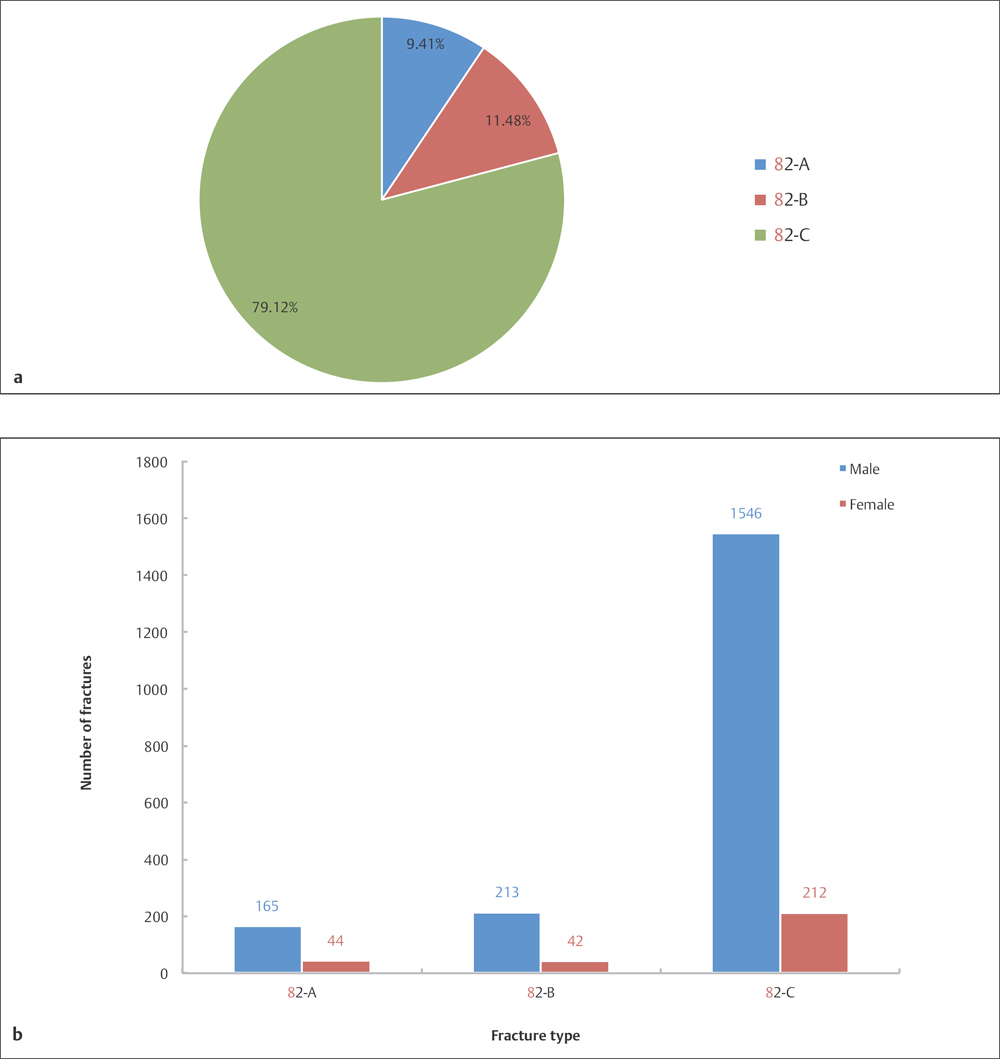
Fig. 9.12 a, b
a Fracture type distribution of 2222 calcaneal fractures.
b Sex and fracture type distribution of 2222 calcaneal fractures.

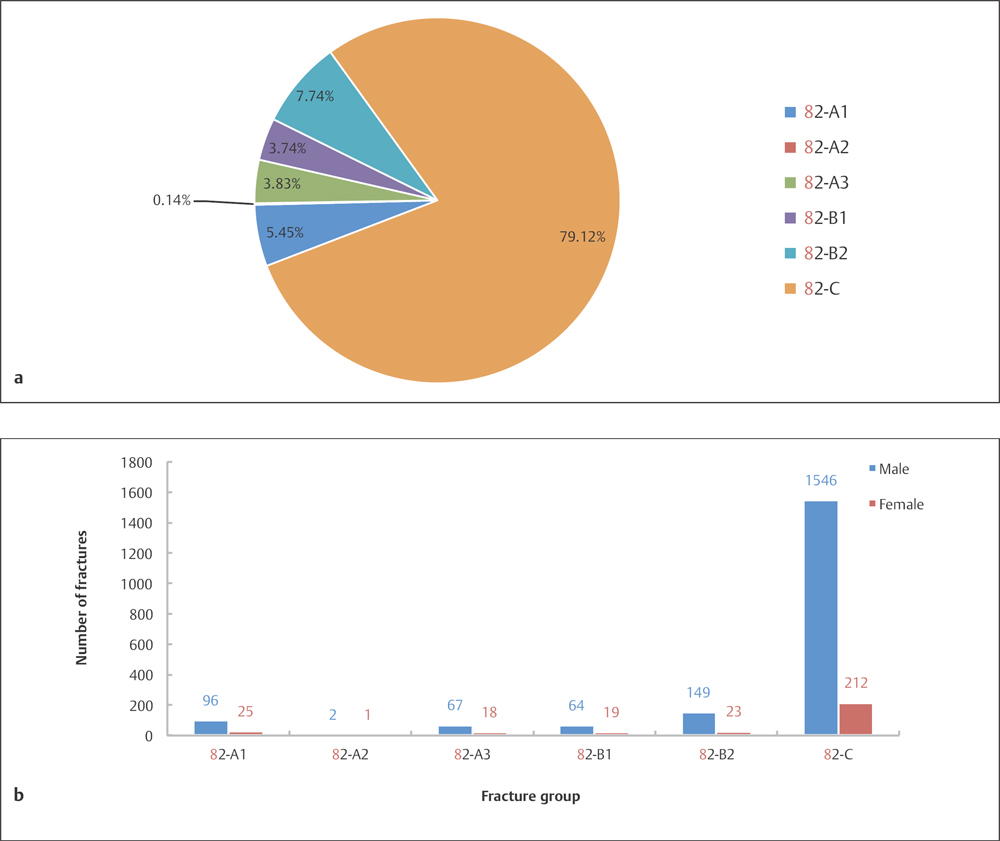
Fig. 9.13 a, b
a Fracture group distribution of 2222 calcaneus fractures.
b Sex and fracture group distribution of 2222 calcaneus fractures.
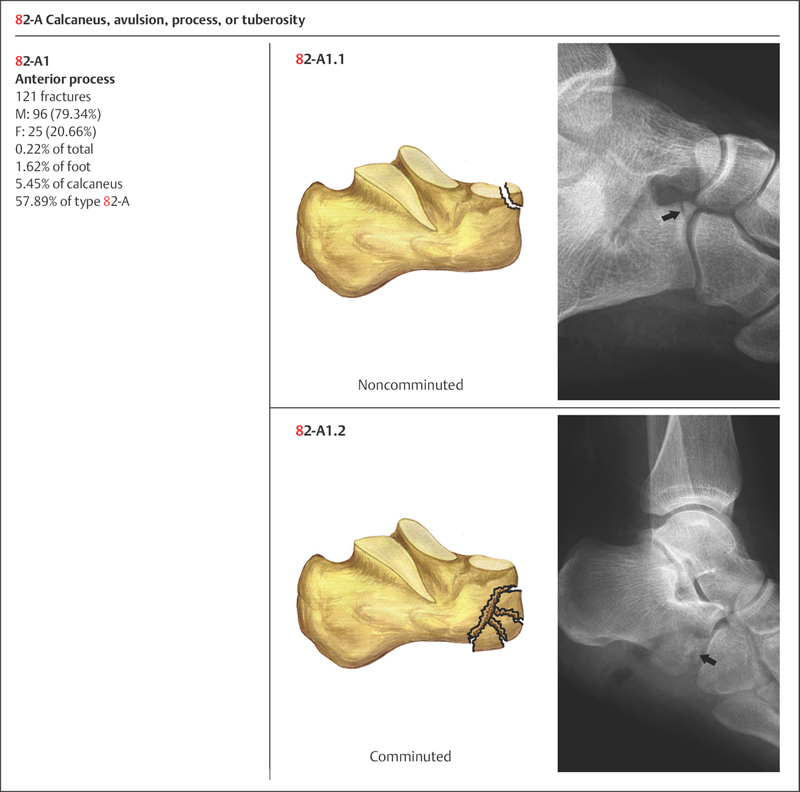
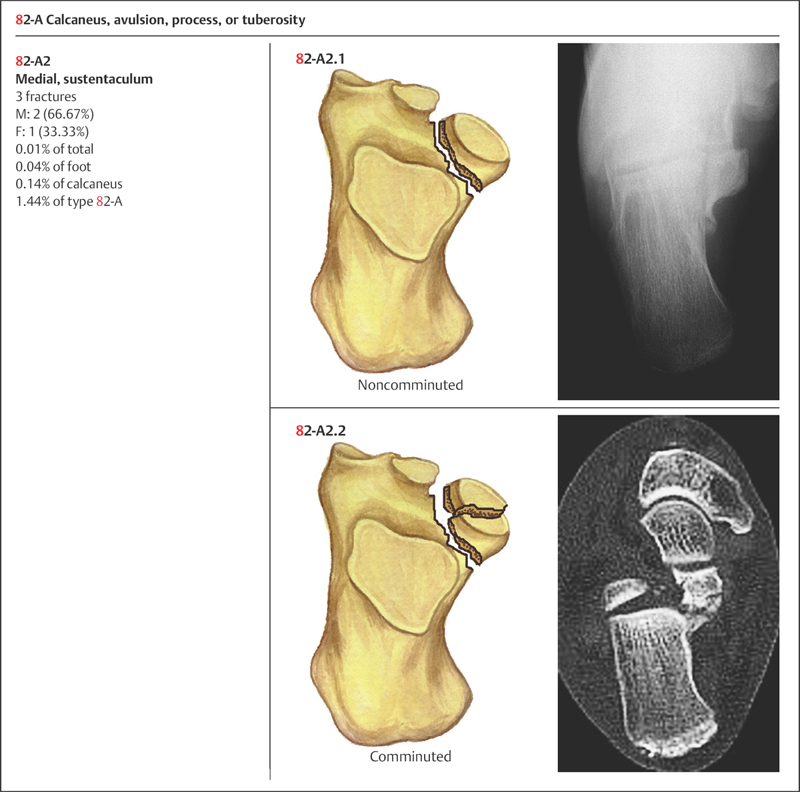


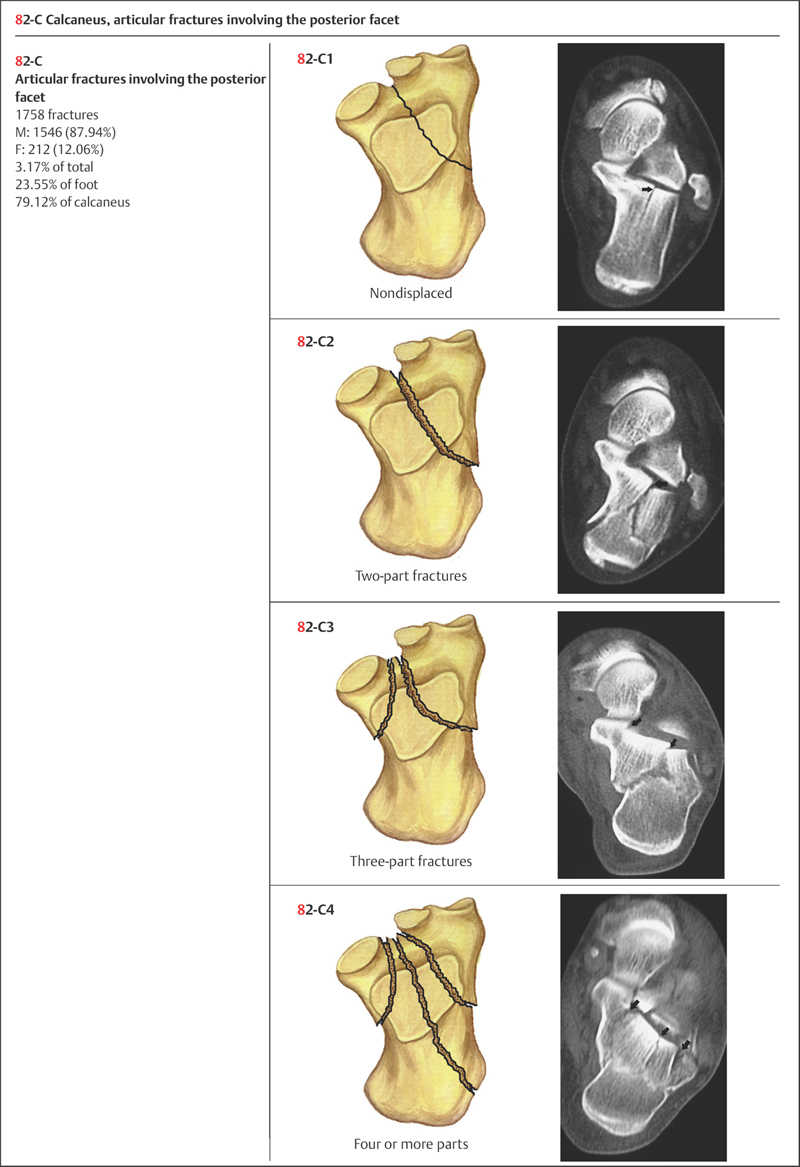
 Injury Mechanism
Injury Mechanism
The patterns of foot fractures vary, depending on the direction of the force that acted on the foot and the position of the foot at the time of injury.
Fractures of the anterior part of the calcaneus usually involve avulsion and depression of the anterior process, with avulsion being the most common fracture of the anterior process. Avulsion fractures of the anterior process usually result from a strong tensile force from the bifurcate ligament, when axial load is applied at the calcaneus while the foot is dorsiflexed and inverted. Depression fractures of the anterior process usually occur as the result of a strong abduction force on the calcaneocuboid articulation surface.
Avulsion fractures of the calcaneal tuberosity tend to occur from avulsion of the Achilles tendon with its bony insertion, due to an abrupt contraction. Less commonly, it can also be the result of a direct force applied on the calcaneus.
Stay updated, free articles. Join our Telegram channel

Full access? Get Clinical Tree








